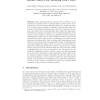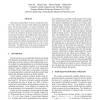ICDM
2003
IEEE
14 years 4 months ago
2003
IEEE
Predictive data mining typically relies on labeled data without exploiting a much larger amount of available unlabeled data. The goal of this paper is to show that using unlabeled...
ECCV
2010
Springer
14 years 4 months ago
2010
Springer
Many learning tasks for computer vision problems can be described by multiple views or multiple features. These views can be exploited in order to learn from unlabeled data, a.k.a....
IJCNLP
2004
Springer
14 years 4 months ago
2004
Springer
Multi-document discourse analysis has emerged with the potential of improving various NLP applications. Based on the newly proposed Cross-document Structure Theory (CST), this pap...
DAGM
2004
Springer
14 years 4 months ago
2004
Springer
We consider the general problem of learning from labeled and unlabeled data. Given a set of points, some of them are labeled, and the remaining points are unlabeled. The goal is to...
COLT
2005
Springer
14 years 5 months ago
2005
Springer
We present two new methods for obtaining generalization error bounds in a semi-supervised setting. Both methods are based on approximating the disagreement probability of pairs of ...
COLT
2005
Springer
14 years 5 months ago
2005
Springer
Abstract. There has been growing interest in practice in using unlabeled data together with labeled data in machine learning, and a number of different approaches have been develo...
ICMCS
2005
IEEE
14 years 5 months ago
2005
IEEE
Training a good text detector requires a large amount of labeled data, which can be very expensive to obtain. Cotraining has been shown to be a powerful semi-supervised learning t...
ICMCS
2005
IEEE
14 years 5 months ago
2005
IEEE
This paper investigates the use of unlabeled data to help labeled data for audio-visual event recognition in meetings. To deal with situations in which it is difficult to collect...
ICDM
2005
IEEE
14 years 5 months ago
2005
IEEE
Sampling has been recognized as an important technique to improve the efficiency of clustering. However, with sampling applied, those points which are not sampled will not have t...
ICDM
2005
IEEE
14 years 5 months ago
2005
IEEE
We propose an algorithm to construct classification models with a mixture of kernels from labeled and unlabeled data. The derived classifier is a mixture of models, each based o...


